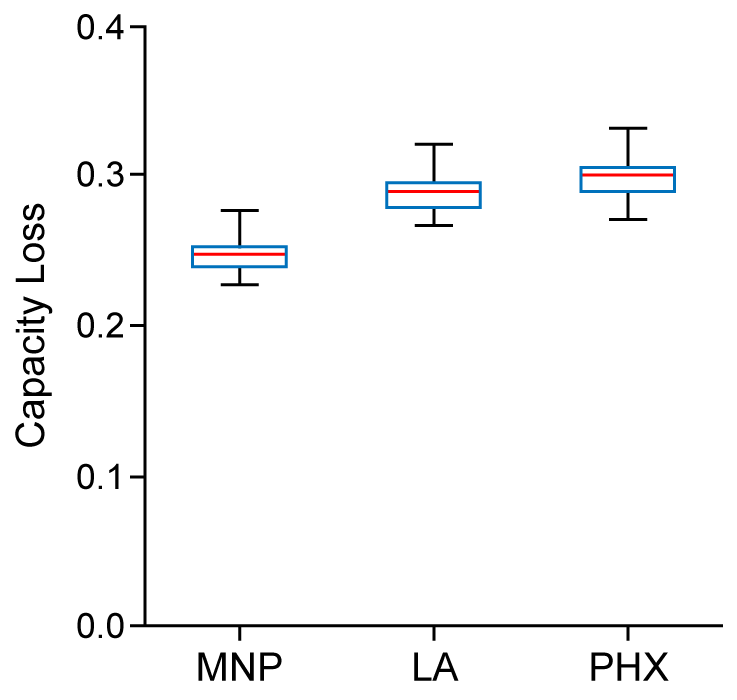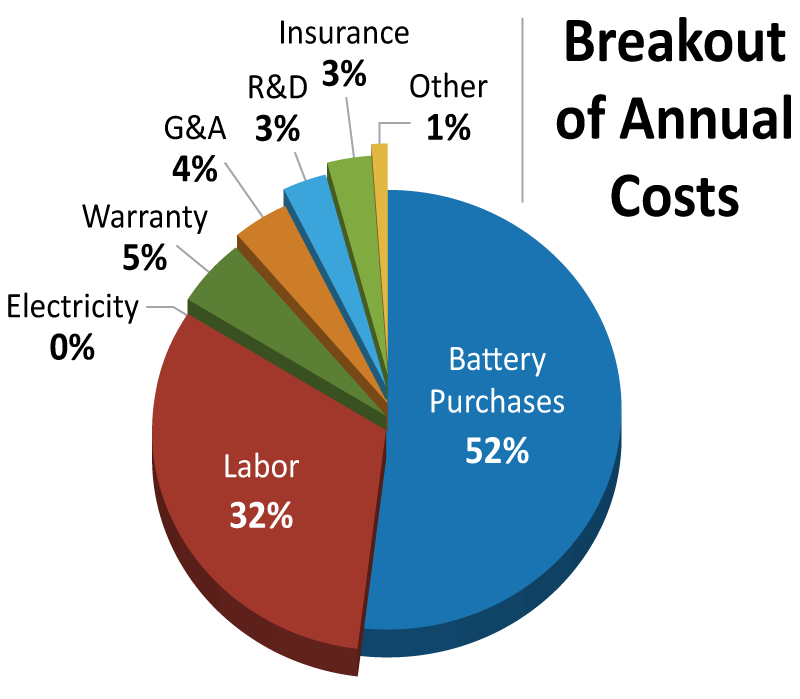Battery Second Use for Plug-In Electric Vehicles Analysis
NREL's battery second use (B2U) analysis study for plug-in electric vehicle (PEV) lithium-ion batteries identified and answered several high-level questions critical to understanding the viability of B2U. These questions are listed below along with a summary of analysis findings.
For more detailed information about the analysis and findings, download the full report.

Box plot of BEV75 battery capacity loss for a selection of drivers in Minneapolis (MNP), Los Angeles (LA), and Phoenix (PHX).
When will used automotive batteries become available, and how healthy will they be?
A detailed analysis was conducted of battery degradation in automotive service, of the economics of battery replacement in automotive service, and of battery degradation in a second use. Results suggest that most PEV batteries will not become available for a second use until the end of the original vehicle's service life. Despite the long automotive service life, it is anticipated that these batteries will retain approximately 70% of their initial capacity remaining and potentially operate for an additional 10 years in their second use when treated properly.
What is required to repurpose used automotive batteries, and how much will it cost?
NREL's investigation found that regional repurposing facilities dedicated to a single model of PEV is likely to minimize repurposing costs while avoiding the increased transportation costs of nationwide battery collection and the complexities of repurposing heterogeneous batteries. As technician labor is the primary cost element of such an operation, repurposing facilities are expected to repurpose battery modules — not cells — to minimize total costs. Use of vehicle diagnostics data to confirm the state of health and absence of faulty cells in modules prior to their purchase is therefore of great value to repurposers. When such data is available, repurposing costs can be as low as $20/kilowatt-hour (kWh)-nameplate.
NREL's repurposing cost calculator is available freely for download, enabling users to explore the effects of different repurposing strategies and assumptions on economics. Download the calculator.

Breakout of capital, labor, and total annual costs reveal that labor costs are a large portion of total module repurposing costs. Labor costs are dominated by technician labor, suggesting that repair, replacement, or extraction of individual cells within modules is unlikely to be economically feasible.
How will repurposed automotive batteries be used, how long will they last, and what is their value?
Both economic (cost of repurposed batteries, value of service provided) and market size (supply of repurposed batteries, demand for service) factors were addressed to identify suitable applications. It was found that the potential supply of second-use batteries can overwhelm the depth of many markets for second-use batteries, often by an order of magnitude or more. The most promising application identified for second use batteries is to replace grid-connected combustion turbine peaker plants and provide peak-shaving services. In comparison to automotive service, use in this application will entail relatively benign duty cycles, under which it is anticipated that second use battery lifetimes will be on the order of 10 years. While the value to the original automotive battery owner is restricted primarily to the elimination of end of service costs (battery extraction, disposal, recycling, etc.), the value to the broader community could be significant: decreased cost of peaker plant operation, reduction of greenhouse gas emissions and fossil fuel consumption, and deferral of battery recycling.
While these answers suggest that B2U will not significantly reduce the upfront cost of PEVs, it does show that B2U can eliminate end-of-service costs for the automotive battery owner and provide low- to zero-emission peaking services to electric utilities, reducing cost, use of fossil fuels, and greenhouse gas emissions. Thus, the overall benefit to society can be quite large.
However, the work also shows that the economic margins that make second use viable are often small, and thus several factors could affect this conclusion. Availability of onboard diagnostics data and accurate assessments of automotive and second-use battery degradation stand out in particular. It is intended that the methods and results of this project will be used as a springboard for others to address the remaining obstacles to widespread B2U of PEV batteries.
Resources
For B2U, many tools and reports are available as additional resources.
-
Analysis Tools and Documentation
-
B2U and Stationary Storage Application Analyses
- Identifying and Overcoming Critical Barriers to Widespread Second Use of PEV Batteries
- A Techno-Economic Analysis of PEV Battery Second Use: Repurposed-Battery Selling Price and Commercial and Industrial End-User Value
- The Ability of Battery Second Use Strategies to Impact Plug-In Electric Vehicle Prices and Serve Utility Energy Storage Applications
- Analyzing the Effects of Climate and Thermal Configuration on Community Energy Storage Systems
- Optimal Sizing of Energy Storage and Photovoltaic Power Systems for Demand Charge Mitigation
- Deployment of Behind-the-Meter Energy Storage for Demand Charge Reduction
-
PEV Battery Lifetime and Performance Analyses
- Thru-life impacts of driver aggression, climate, cabin thermal management, and battery thermal management on battery electric vehicle utility
- The impact of range anxiety and home, workplace, and public charging infrastructure on simulated battery electric vehicle lifetime utility
- Sensitivity of Plug-In Hybrid Electric Vehicle Economics to Drive Patterns, Electric Range, Energy Management, and Charge Strategies
- Models for Battery Reliability and Lifetime
- Sensitivity of Battery Electric Vehicle Economics to Drive Patterns, Vehicle Range, and Charge Strategies
Contact
For more information about NREL's PEV battery second use research and analysis, contact Kandler Smith, 303-275-4423.
Share

